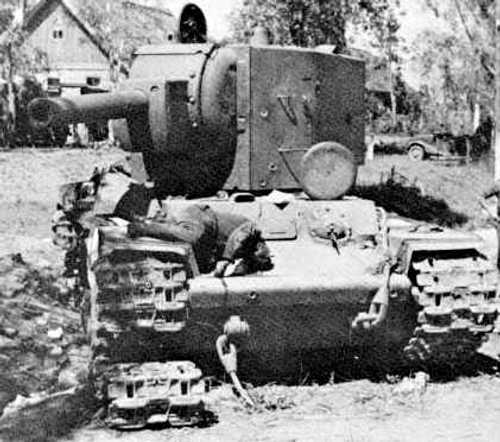
Giant immobilised ... KV-2.
If the Germans were unpleasantly surprised by the KV-1 and the T-34A, they were not particularly pleased to meet the KV-2 either. This was a Soviet take on the "breakthrough tank" concept, designed to supply infantry support and bunker-busting against fixed fortifications. It was slow (some 16 kmph on road, slower off-road) and had a very high profile but, on the other hand, packed a 152mm gun-howitzer with bunker-busting in mind. This could be turned very effectively to anti-tank use. The Germans - whose anti-tank guns (other than the AA "88") were pretty useless against these monsters - except when it came to detracking them. However, simply immobilizing a KV-2 did not necessarily end the problem. KV-1s and KV-2s were particularly prominent in the Army Group North area, owing to the fact that a major production facility for these vehicles was located at Leningrad. The forested, swamp-infested territory over which Army Group North had to pass offered ample opportunity for the Red Army to conduct blocking actions at strategically important locations which could not effectively be bypassed. The KV-2 was very effective in this role. A KV-2, sitting in the middle of a street in an "un-bypassable" village, could absorb considerable damage while firing back - even if detracked. Soviet crews, where supported by infantry, tended to fire back until they had run out of ammunition, or were "killed" by an "88". Since its large gun could destroy any German tank in the field - even with high-explosive or bunker-busting ammunition - this practice caused repeated delays to the progress of Army Group North towards Leningrad. The weaknesses of the KV-2 were quickly recognized by the Soviets, who went on to develop more effective replacements. Nonetheless, it played its part. Best regards, JR.
This is a companion discussion topic for the original entry at https://www.ww2incolor.com/gallery/soviet-forces/53405/giant-immobilised-...-kv-2.
